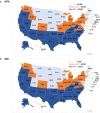Association Between Social Vulnerability Index and Cardiovascular Disease: A Behavioral Risk Factor Surveillance System Study
- PMID: 35904206
- PMCID: PMC9375494
- DOI: 10.1161/JAHA.121.024414
Association Between Social Vulnerability Index and Cardiovascular Disease: A Behavioral Risk Factor Surveillance System Study
Abstract
Background Social and environmental factors play an important role in the rising health care burden of cardiovascular disease. The Centers for Disease Control and Prevention developed the Social Vulnerability Index (SVI) from US census data as a tool for public health officials to identify communities in need of support in the setting of a hazardous event. SVI (ranging from a least vulnerable score of 0 to a most vulnerable score of 1) ranks communities on 15 social factors including unemployment, minoritized groups status, and disability, and groups them under 4 broad themes: socioeconomic status, housing and transportation, minoritized groups, and household composition. We sought to assess the association of SVI with self-reported prevalent cardiovascular comorbidities and atherosclerotic cardiovascular disease (ASCVD). Methods and Results We performed a retrospective cohort analysis of adults (≥18 years) in the Behavioral Risk Factor Surveillance System 2016 to 2019. Data regarding self-reported prevalent cardiovascular comorbidities (including diabetes, hypertension, hyperlipidemia, smoking, substance use), and ASCVD was captured using participants' response to a structured telephonic interview. We divided states on the basis of the tertile of SVI (first-participant lives in the least vulnerable group of states, 0-0.32; to third-participant lives in the most vulnerable group of states, 0.54-1.0). Multivariable logistic regression models adjusting for age, race and ethnicity, sex, employment, income, health care coverage, and association with federal poverty line were constructed to assess the association of SVI with cardiovascular comorbidities. Our study sample consisted of 1 745 999 participants ≥18 years of age. States in the highest (third) tertile of social vulnerability had predominantly Black and Hispanic adults, lower levels of education, lower income, higher rates of unemployment, and higher rates of prevalent comorbidities including hypertension, diabetes, chronic kidney disease, hyperlipidemia, substance use, and ASCVD. In multivariable logistic regression models, individuals living in states in the third tertile of SVI had higher odds of having hypertension (odds ratio (OR), 1.14 [95% CI, 1.11-1.17]), diabetes (OR, 1.12 [95% CI, 1.09-1.15]), hyperlipidemia (OR, 1.09 [95% CI, 1.06-1.12]), chronic kidney disease (OR, 1.17 [95% CI, 1.12-1.23]), smoking (OR, 1.05 [95% CI, 1.03-1.07]), and ASCVD (OR, 1.15 [95% CI, 1.12-1.19]), compared with those living in the first tertile of SVI. Conclusions SVI varies across the US states and is associated with prevalent cardiovascular comorbidities and ASCVD, independent of age, race and ethnicity, sex, employment, income, and health care coverage. SVI may be a useful assessment tool for health policy makers and health systems researchers examining multilevel influences on cardiovascular-related health behaviors and identifying communities for targeted interventions pertaining to social determinants of health.
Keywords: SVI; cardiovascular disease; risk factors; social vulnerability.
Figures


Similar articles
-
Social Vulnerability Index and Cardiovascular Disease Care Continuum: A Scoping Review.JACC Adv. 2024 Mar 6;3(7):100858. doi: 10.1016/j.jacadv.2024.100858. eCollection 2024 Jul. JACC Adv. 2024. PMID: 39130018 Free PMC article.
-
State-Level Social Vulnerability Index and Healthcare Access in Patients With Atherosclerotic Cardiovascular Disease (from the BRFSS Survey).Am J Cardiol. 2022 Sep 1;178:149-153. doi: 10.1016/j.amjcard.2022.05.025. Epub 2022 Jul 2. Am J Cardiol. 2022. PMID: 35787337
-
Social Vulnerability and Premature Cardiovascular Mortality Among US Counties, 2014 to 2018.Circulation. 2021 Oct 19;144(16):1272-1279. doi: 10.1161/CIRCULATIONAHA.121.054516. Epub 2021 Oct 18. Circulation. 2021. PMID: 34662161
-
County-Level Social Vulnerability is Associated With In-Hospital Death and Major Adverse Cardiovascular Events in Patients Hospitalized With COVID-19: An Analysis of the American Heart Association COVID-19 Cardiovascular Disease Registry.Circ Cardiovasc Qual Outcomes. 2022 Aug;15(8):e008612. doi: 10.1161/CIRCOUTCOMES.121.008612. Epub 2022 Jul 18. Circ Cardiovasc Qual Outcomes. 2022. PMID: 35862003 Free PMC article.
-
Use of Preventive Cardiovascular Health Care Among Asian American Individuals: A National Health Interview Survey Study.Curr Probl Cardiol. 2023 Aug;48(8):101241. doi: 10.1016/j.cpcardiol.2022.101241. Epub 2022 May 2. Curr Probl Cardiol. 2023. PMID: 35513186 Review.
Cited by
-
Statin Utilization Among Individuals Infected With Hepatitis C Virus: A Retrospective Cohort Study.Cureus. 2023 Mar 12;15(3):e36049. doi: 10.7759/cureus.36049. eCollection 2023 Mar. Cureus. 2023. PMID: 37056557 Free PMC article.
-
Social vulnerability index associated with higher COVID-19 seroprevalence in Nigeria.Glob Health Action. 2024 Dec 31;17(1):2446043. doi: 10.1080/16549716.2024.2446043. Epub 2025 Jan 21. Glob Health Action. 2024. PMID: 39834339 Free PMC article.
-
Integrating Social Determinants of Health in Machine Learning-Driven Decision Support for Diabetes Case Management: Protocol for a Sequential Mixed Methods Study.JMIR Res Protoc. 2024 Sep 25;13:e56049. doi: 10.2196/56049. JMIR Res Protoc. 2024. PMID: 39321449 Free PMC article.
-
Social vulnerability and lung malignancy mortality.J Cancer Policy. 2023 Dec;38:100453. doi: 10.1016/j.jcpo.2023.100453. Epub 2023 Nov 17. J Cancer Policy. 2023. PMID: 37977216 Free PMC article.
-
Social Vulnerability Index and Cardiovascular Disease Care Continuum: A Scoping Review.JACC Adv. 2024 Mar 6;3(7):100858. doi: 10.1016/j.jacadv.2024.100858. eCollection 2024 Jul. JACC Adv. 2024. PMID: 39130018 Free PMC article.
References
-
- Health and Economic Costs of Chronic Diseases|CDC . June 23, 2021. Available at: https://www.cdc.gov/chronicdisease/about/costs/index.htm. Accessed July 13, 2021.
-
- Carnethon MR, Pu J, Howard G, Albert MA, Anderson CAM, Bertoni AG, Mujahid MS, Palaniappan L, Taylor HA Jr, Willis M, et al. Cardiovascular health in African Americans: a scientific statement from the American Heart Association. Circulation. 2017;136(21):e393–e423. doi: 10.1161/CIR.0000000000000534 - DOI - PubMed
Publication types
MeSH terms
Grants and funding
LinkOut - more resources
Full Text Sources
Medical

